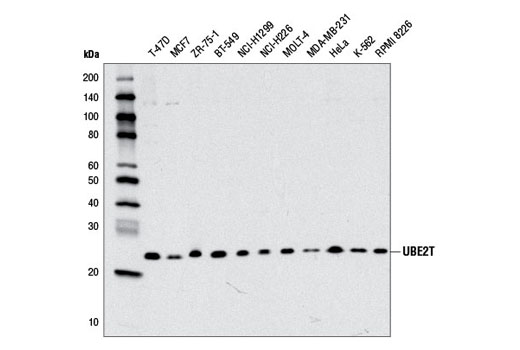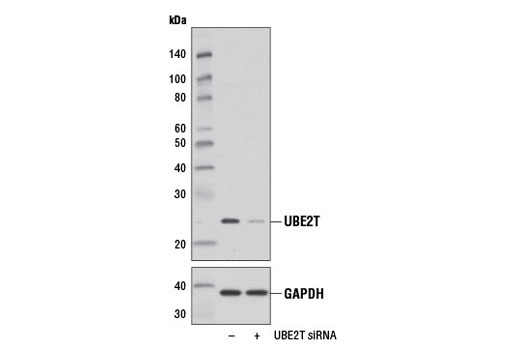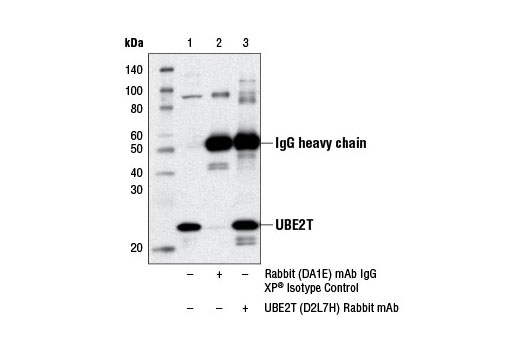WB, IP
H
Endogenous
25
Rabbit IgG
#Q9NPD8
29089
Product Information
Product Usage Information
| Application | Dilution |
|---|---|
| Western Blotting | 1:1000 |
| Immunoprecipitation | 1:50 |
Storage
Specificity / Sensitivity
Species Reactivity:
Human
Source / Purification
Monoclonal antibody is produced by immunizing animals with a synthetic peptide corresponding to residues surrounding His150 of human UBE2T protein.
Background
Protein ubiquitination requires the concerted action of the E1, E2, and E3 ubiquitin-conjugating enzymes. Ubiquitin is first activated through ATP-dependent formation of a thiol ester with ubiquitin-activating enzyme E1. The activated ubiquitin is then transferred to a thiol group of ubiquitin-carrier enzyme E2. The final step is the transfer of ubiquitin from E2 to an ε-amino group of the target protein lysine residue, which is mediated by ubiquitin-ligase enzyme E3 (1).
Ubiquitin conjugating-enzyme 2T (UBE2T) is an E2 family member responsible for the ATP-dependent ubiquitin tagging of target proteins for degradation. Research studies indicate that UBE2T plays an important role in the Fanconi anemia pathway and that UBE2T expression is required for normal DNA repair through this pathway. Interaction between UBE2T and FANCL appears to stimulate UBE2T auto monoubiquitination, leading to UBE2T inactivation and negative regulation of the Fanconi anemia pathway (2-4). Additional research details upregulation of UBE2T expression in breast cancer cells and certain lung carcinomas, suggesting a possible involvement in these malignancies (5,6).
Species Reactivity
Species reactivity is determined by testing in at least one approved application (e.g., western blot).
Western Blot Buffer
IMPORTANT: For western blots, incubate membrane with diluted primary antibody in 5% w/v nonfat dry milk, 1X TBS, 0.1% Tween® 20 at 4°C with gentle shaking, overnight.
Applications Key
WB: Western Blotting IP: Immunoprecipitation
Cross-Reactivity Key
H: human M: mouse R: rat Hm: hamster Mk: monkey Vir: virus Mi: mink C: chicken Dm: D. melanogaster X: Xenopus Z: zebrafish B: bovine Dg: dog Pg: pig Sc: S. cerevisiae Ce: C. elegans Hr: horse GP: Guinea Pig Rab: rabbit All: all species expected
Trademarks and Patents
Limited Uses
Except as otherwise expressly agreed in a writing signed by a legally authorized representative of CST, the following terms apply to Products provided by CST, its affiliates or its distributors. Any Customer's terms and conditions that are in addition to, or different from, those contained herein, unless separately accepted in writing by a legally authorized representative of CST, are rejected and are of no force or effect.
Products are labeled with For Research Use Only or a similar labeling statement and have not been approved, cleared, or licensed by the FDA or other regulatory foreign or domestic entity, for any purpose. Customer shall not use any Product for any diagnostic or therapeutic purpose, or otherwise in any manner that conflicts with its labeling statement. Products sold or licensed by CST are provided for Customer as the end-user and solely for research and development uses. Any use of Product for diagnostic, prophylactic or therapeutic purposes, or any purchase of Product for resale (alone or as a component) or other commercial purpose, requires a separate license from CST. Customer shall (a) not sell, license, loan, donate or otherwise transfer or make available any Product to any third party, whether alone or in combination with other materials, or use the Products to manufacture any commercial products, (b) not copy, modify, reverse engineer, decompile, disassemble or otherwise attempt to discover the underlying structure or technology of the Products, or use the Products for the purpose of developing any products or services that would compete with CST products or services, (c) not alter or remove from the Products any trademarks, trade names, logos, patent or copyright notices or markings, (d) use the Products solely in accordance with CST Product Terms of Sale and any applicable documentation, and (e) comply with any license, terms of service or similar agreement with respect to any third party products or services used by Customer in connection with the Products.



